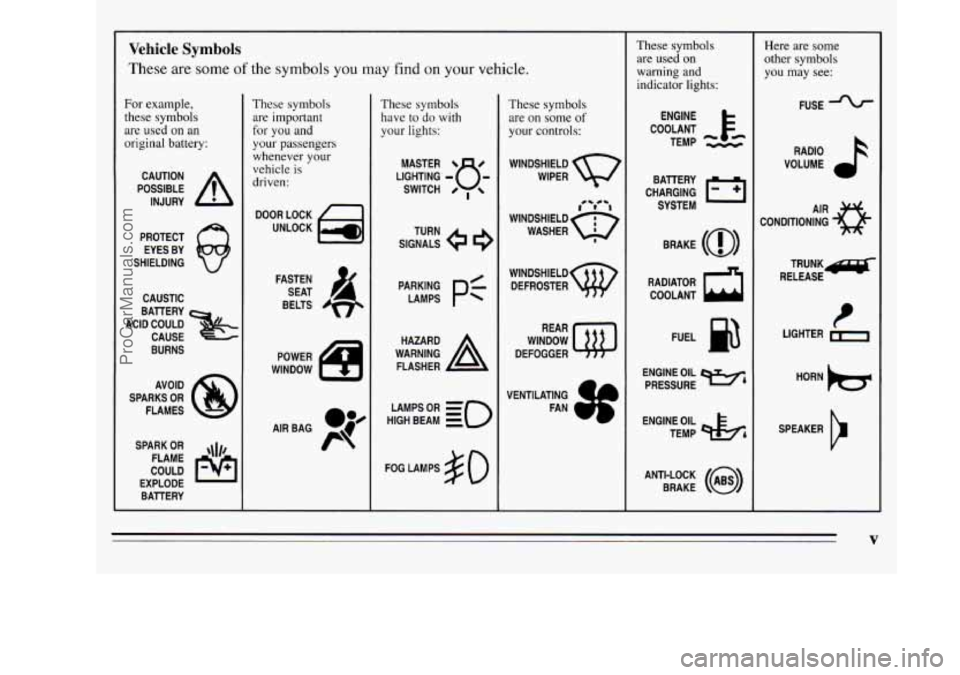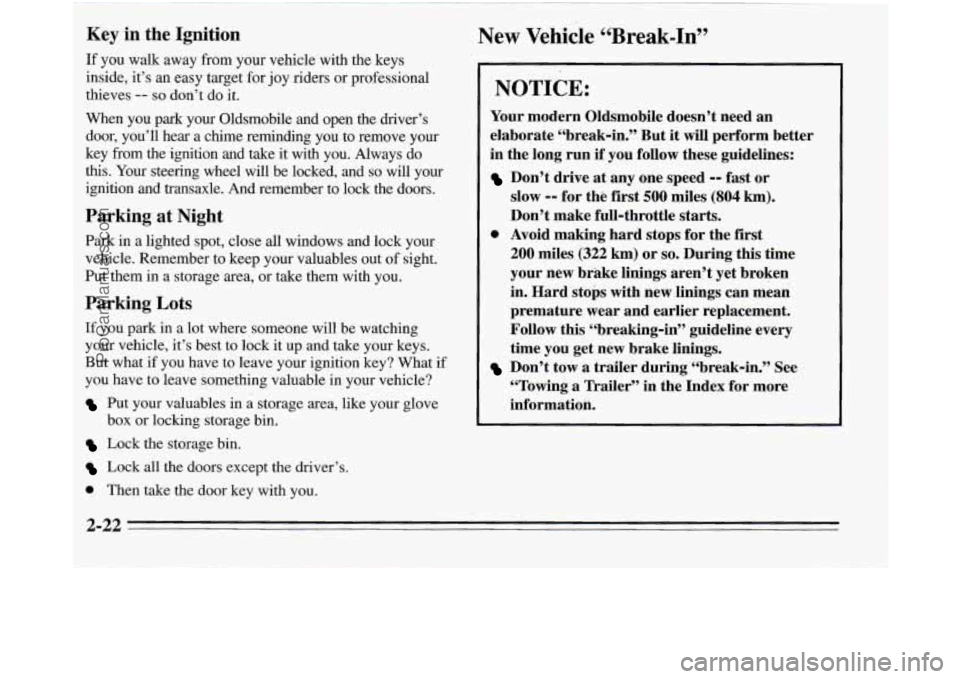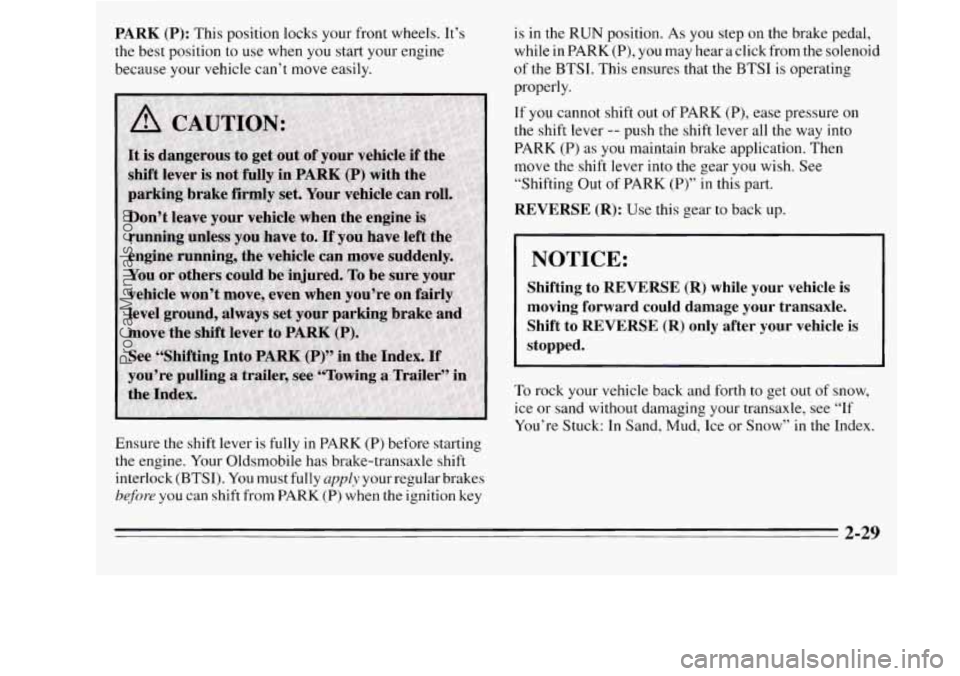brake OLDSMOBILE SILHOUETTE 1995 Owners Manual
[x] Cancel search | Manufacturer: OLDSMOBILE, Model Year: 1995, Model line: SILHOUETTE, Model: OLDSMOBILE SILHOUETTE 1995Pages: 390, PDF Size: 20.27 MB
Page 9 of 390

L
Vehicle Symbols
These are some of the symbols you may find on your vehicle.
For example,
these symbols are used on an
original battery:
POSSIBLE A
CAUTION
INJURY
PROTECT EYES BY
SHIELDING
CAUSTIC
ACID COULD BAlTERY
CAUSE
BURNS
AVOID
SPARKS
OR
FLAMES
SPARK
OR ,111,
COULD FLAME
EXPLODE BAllERY
These symbols are important
for you and
your passengers whenever your
vehicle is
driven:
DOOR LOCK
UNLOCK
FASTEN SEAT
BELTS
POWER
WINDOW
These symbols have to do with
your lights:
SIGNALS e e3
TURN
WARNING
A
HAZARD
FLASHER
HIGH
LAMPSoR BEAM = zo
FOG LAMPS $0
These symbols
are on some
of
your controls:
WINDSHIELD
WIPER
WINDSHIELD DEFROSTER
WINDOW
DEFOGGER
VENTILATING FAN
These symbols are used on
warning and
indicator lights:
COOLANT F-
TEMP --
ENGINE
CHARGING BAllERY
SYSTEM
BRAKE
(a)
RADIATOR COOLANT
a
FUEL
ENGINE OIL
PRESSURE
w4
TEMP OIL pk;
ANTI-LOCK (a)
BRAKE
Here are some
other symbols
you may see:
FUSE
RADIO
VOLUME
CONDITIONING
43
TRUNX~
RELEASE
HORN
)tr
SPEAKER
b
V
ProCarManuals.com
Page 92 of 390

Key in the Ignition
If you walk away from your vehicle with the keys
inside, it’s an easy target for joy riders or professional
thieves
-- so don’t do it.
New Vehicle ''Break-in"
When you park your Oldsmobile and open the driver’s
door’ you’ll hear a chime reminding you to remove your
key from the ignition and take it with you. Always
do
this. Your steering wheel will be locked, and so will your
ignition and transaxle. And remember to lock the doors.
Parking at Night
Park in a lighted spot, close all windows and lock your
vehicle. Remember to keep your valuables out
of sight.
Put them in a storage area, or take them with you.
Parking Lots
If you park in a lot where someone will be watching
your vehicle, it’s best to lock it up and take your keys.
But what if you have to leave your ignition key? What if
you have
to leave something valuable in your vehicle?
Put your valuables in a storage area, like your glove
box or locking storage bin.
Lock the storage bin.
Lock all the doors except the driver’s.
0 Then take the door key with you.
NOTICE:
Your modern Oldsmobile doesn’t need an
elaborate “break-in.” But it
will perform better
in the long run if you follow these guidelines:
Don’t drive at any one speed -- fast or
slow
-- for the first 500 miles (804 km).
Don’t make full-throttle starts.
200 miles (322 km) or so. During this time
your new brake linings aren’t yet broken
in. Hard stops with new linings can mean
premature wear and earlier replacement.
Follow this “breaking-in” guideline every
time you get new brake linings.
Don’t tow a trailer during “break-in.” See
“Towing
a Trailer” in the Index for more
information.
0 Avoid making hard stops for the first
2-22
ProCarManuals.com
Page 99 of 390

PARK (P): This position locks your front wheels. It’s
the best position to
use when you start your engine
because your vehicle can’t move easily.
Ensure the shift lever
is fully in PARK (P) before starting
the engine. Your Oldsmobile has brake-transaxle shift
interlock
(BTSI). You must fully apply your regular brakes
before you can shift from PARK (P) when the ignition key is
in the RUN position.
As you step on the brake pedal,
while in PARK (P),
you may hear a click from the solenoid
of the
BTSI. This ensures that the BTSI is operating
properly.
If you cannot shift out of PARK (P), ease pressure on
the shift lever
-- push the shift lever all the way into
PARK (P) as you maintain brake application. Then
move the shift lever into the gear you wish. See
“Shifting Out of PARK
(P)” in this part.
REVERSE (R): Use this gear to back up.
I NOTICE: I
Shifting to REVERSE (R) while your vehicle is
moving forward could damage your transaxle. Shift to REVERSE
(R) only after your vehicle is
stopped.
To rock your vehicle back and forth to get out of snow,
ice or sand without damaging your transaxle, see “If
You’re Stuck: In Sand,
Mud, Ice or Snow” in the Index.
2-29
ProCarManuals.com
Page 101 of 390

If your automatic transaxle has OVERDRIVE (@),
NOTICE: THIRD (D) is like OVERDRIVE (D), but you never go
into Overdrive. Here are some times you might choose
This NOTICE applies only if you have the 3800 THIRD (D) instead of OVERDRIVE (@):
V6 engine and the automatic overdrive transaxle.
If your vehicle is so equipped, and if it seems to 0 When driving on hilly, winding roads.
start up rather slowly, or if it seems not to shift
far that way, your vehicle can be damaged. So, if
When going down a steep hill. with a transaxle system sensor. If you drive very
between gears. gears as you go faster, something may be wrong
When towing a trailer, so there is less shifting
this happens, have your vehicle serviced right SECOND GEAR (2): This position
gives you
away. Until then, you can use SECOND (2) when more power, but lower fuel economy. You can use
SECOND
(2) on hills. It can help control your speed as you are driving less than 35 mph (56 km/h) and you go down steep mountain roads, but then you would
OVERDRIVE (0) for higher speeds. also want to use your brakes off and on.
THIRD GEAR (D): If your automatic transaxle does
not have
OVERDRIVE (@), this position is for normal
driving, at all speeds, in most street and highway
situations. NOTICE:
Don’t drive in SECOND (2) for more than 5 miles
(8 km), or at speeds over 55 mph (88 km/h), or
you can damage your transaxle. Use THIRD (D)
(OVERDRIVE (a) or THIRD (D) if your vehicle
has OVERDRIVE
(a)) as much as possible.
Don’t shift into SECOND
(2) unless you are going
slower than 65 mph
(105 km/h), or you can
damage your engine.
2-31
ProCarManuals.com
Page 102 of 390

FIRST GEAR (1): This position gives you even more
power,
but lower fuel economy, than SECOND (2). You
can
use it on very steep hills, or in deep snow or mud. If
the selector lever is put in FIRST
(1), the transaxle
won’t shift into first gear until the vehicle is going
slowly enough.
_-
NOTICE:
If your front wheels can’t rotate, don’t try to
drive. This might happen if you were stuck in
very deep sand or mud
or were up against a solid
object. You could damage your transaxle.
Also, if you stop when going uphill, don’t hold
your vehicle there with only the accelerator
pedal. This could overheat and damage the
transaxle.
Use your brakes or shift into PARK (P)
to hold your vehicle in position on a hill.
Parking Brake
To set the parking brake, hold the regular brake pedal
down with your right foot and push down the parking
brake pedal with your left foot. If the ignition is on, the
brake system warning light will come on. See “Brake
System Warning Light” in the Index.
ProCarManuals.com
Page 103 of 390

To release the parking brake, hold the regular brake
pedal down with your right foot while you push down
on the parking brake pedal with your left foot.
(To
release the tension on the parking brake cable, you will
need to apply about the same amount of pressure to the
parking brake pedal as you did when you set the parking
brake.) When
you remove your foot from the parking
brake pedal, it will pop up
to the release position.
I NOTICE:
Driving with the parking brake on can cause
your rear brakes to overheat.
You may have to
replace them, and
you could also damage other
parts
of your vehicle.
Shifting Into PARK (P)
If you are towing a trailer and are parking on any hill,
see “Towing a Trailer” in the Index. That section shows
1. Hold the brake pedal down with your right foot and
set the parking brake with
your left foot.
what to do first to keep the trailer
from moving.
2-33
ProCarManuals.com
Page 105 of 390

Leaving Your Vehicle With the Engine
Running
If you have to leave your vehicle with the engine
running, be sure your vehicle is in PARK (P) and your
parking brake is firmly set before you leave it. After
you’ve moved the shift lever into the PARK (P)
position, hold the regular brake pedal down. Then, see if
you can move the shift lever away from PARK (P)
without first pulling it toward you.
If you can, it means that the shift lever wasn’t fully
locked into PARK
(P).
Torque Lock
If you are parking on a hill and you don’t shift your
transaxle into PARK (P) properly, the weight
of the
vehicle may put too much force on the parking pawl in
the transaxle. You may find it difficult to pull the shift
lever out of PARK (P). This
is called “torque lock.” To
prevent torque lock, set the parking brake and then shift
into PARK (P) properly before you leave the driver’s
seat.
To find out how, see “Shifting Into PARK (P)” in
the Index.
When you are ready to drive, move the shift lever out of
PARK (P) before you release the parking brake.
If “torque
lock” does occur, you may need to have
another vehicle push yours a little uphill to take some of
the pressure from the transaxle,
so you can pull the shift
lever out of PARK (P).
2-35
ProCarManuals.com
Page 106 of 390

Shifting Out of PARK (P)
Your Uldsmobile has braketransaxle shift interlock.
You have to fully uppZy your regular brake before you
can shift from PARK (P), when the ignition is in the
RUN position. See “Shifting the Automatic Transaxle”
in
the Index.
~f you cmot wt out of PARK e), ,&e pressure on
the shift lever A- push the shift lever all the way into
PARR (P) as you maintain brake application. Then
move the shift lever into the gear you want. If you ever
hold
the brake pedal down but still can’t shift out of’
1. Turn the key to OFF.
2. Apply and hold the brake til the end of Step 4.
PARK (P), try this:
3. shift to NEUTRAL m.
4. Start the vehicle and then shift to the drive gear you
5. Have the vehicle €ixd as soon as you can.
want.
Parking Over Things That Burn
2-36
ProCarManuals.com
Page 114 of 390

Rear Window Wiper and Washer
To use your rear wiper, slide the lower control to the
rear window wiper symbol.
For a delayed wiper cycle, slide the lower control
to DELAY
To wash the rear window, slide the lower control to the
rear window washer symbol and hold
it. The washer and
wiper will operate only as long as the control
is held in
that position. Then the wiper will return to
DELAY.
Cruise Control (Option)
OFF ON RESUME
4-m ACCEL
I
SET b m CRU'SE
With cruise control, you can maintain a speed of about
25 mph (40 kmh) or more without keeping your foot on
the accelerator. This can really help
on long trips.
Cruise control does not work at speeds below
about
25 mph (40 kmh).
When you apply your brakes, the cruise control shuts
off.
2-44
ProCarManuals.com
Page 116 of 390

OFF ON RESUME ACCEL
3. Push in the SET button at the end of the lever and
release it.
4. Take your foot off the accelerator pedal.
To Resume a Set Speed
E
OFF ON RESUME
II=-- ACCEL
CRUISE
Suppose you set your cruise control at a desired speed
and then you apply the brake.
This, of course, shuts
off the cruise control. But you don’t need to reset it.
Once you’re going about
25 mph (40 km/h) or more,
you can move the cruise control switch from
ON to
RESUME/ACCEL (WA) for about half a second.
,
ProCarManuals.com